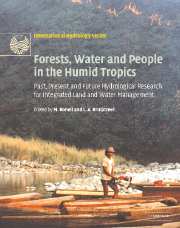 Forests, Water and People in the Humid Tropics
Forests, Water and People in the Humid Tropics Book contents
- Frontmatter
- Contents
- List of contributors
- Foreword
- Preface
- Acknowledgements
- Symposium and Workshop
- Introduction
- Part I Current trends and perspectives on people–land use–water issues
- 1 Trends and patterns of tropical land use change
- 2 The myth of efficiency through market economics: a biophysical analysis of tropical economies, especially with respect to energy, forests and water
- 3 Impacts of land cover change in the Brazilian Amazon: a resource manager's perspective
- 4 Forest people and changing tropical forestland use in tropical Asia
- 5 People in tropical forests: problem or solution?
- 6 Useful myths and intractable truths: the politics of the link between forests and water in Central America
- 7 Land use, hydrological function and economic valuation
- 8 Water resources management policy responses to land cover change in South East Asian river basins
- 9 Community-based hydrological and water quality assessments in Mindanao, Philippines
- Part II Hydrological processes in undisturbed forests
- Part III Forest disturbance, conversion and recovery
- Part IV New methods for evaluating effects of land-use change
- Part V Critical appraisals of best management practices
- Conclusion: Forests, water and people in the humid tropics: an emerging view
- Plate section
- References
4 - Forest people and changing tropical forestland use in tropical Asia
from Part I - Current trends and perspectives on people–land use–water issues
Published online by Cambridge University Press: 12 January 2010
- Frontmatter
- Contents
- List of contributors
- Foreword
- Preface
- Acknowledgements
- Symposium and Workshop
- Introduction
- Part I Current trends and perspectives on people–land use–water issues
- 1 Trends and patterns of tropical land use change
- 2 The myth of efficiency through market economics: a biophysical analysis of tropical economies, especially with respect to energy, forests and water
- 3 Impacts of land cover change in the Brazilian Amazon: a resource manager's perspective
- 4 Forest people and changing tropical forestland use in tropical Asia
- 5 People in tropical forests: problem or solution?
- 6 Useful myths and intractable truths: the politics of the link between forests and water in Central America
- 7 Land use, hydrological function and economic valuation
- 8 Water resources management policy responses to land cover change in South East Asian river basins
- 9 Community-based hydrological and water quality assessments in Mindanao, Philippines
- Part II Hydrological processes in undisturbed forests
- Part III Forest disturbance, conversion and recovery
- Part IV New methods for evaluating effects of land-use change
- Part V Critical appraisals of best management practices
- Conclusion: Forests, water and people in the humid tropics: an emerging view
- Plate section
- References
Summary
FOREST DWELLERS AND FORESTS
Until the latter part of the nineteenth century, most people living in the world's moist tropical forests were almost completely dependent on forestland and resources for food, shelter, medicine and trade products. Small groups typically claimed use rights over a specific area of forest and controlled access to agricultural plots and forest resources through customary law reinforced, in many cases, by religious restrictions. Most forest dwellers were isolated physically from the outside world by distance and natural barriers. They lived at or beyond the periphery of modern society and the market economy. The outside world had little interest in these people or forest resources, with the exception of a few high-value non-timber forest products (NTFPs) and timber species, some of which were traded for centuries.
The isolation that shaped interactions between forest dwellers and tropical forests began to be undermined when national governments and colonial powers extended their power into forested hinterlands; frequently accompanied by laws that shifted legal control of forestland and resources to the state (Poffenberger, 1999; Brookfield et al., 1995). The super-imposition of formal tenure systems over traditional tenure had little initial impact on the lives of most forest dwellers because governments lacked the resources needed to enforce these laws and, in any case, there were few forest resources valuable enough to justify commercial exploitation.
- Type
- Chapter
- Information
- Forests, Water and People in the Humid TropicsPast, Present and Future Hydrological Research for Integrated Land and Water Management, pp. 66 - 74Publisher: Cambridge University PressPrint publication year: 2005
References
- 1
- Cited by


